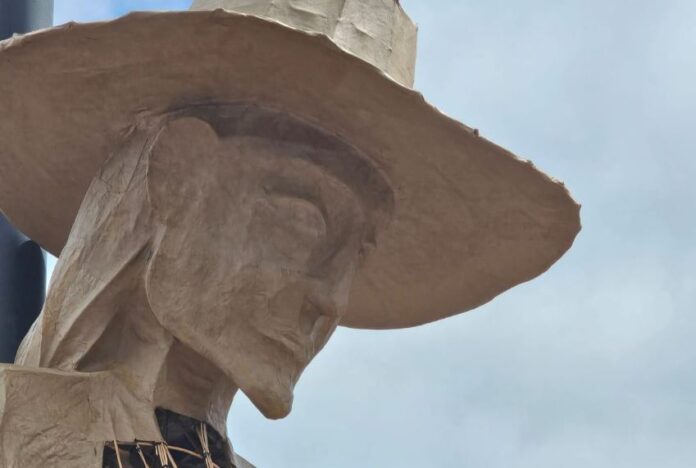Mexican and English artists have constructed a sculpture of a searching mother, aiming to spotlight the struggles of families searching for missing persons, often loved ones, in Mexico and to foster international empathy through art.
The monument “Madre Buscadora” — a widely used term in Mexico that translates to “Searching Mother” — was built during a five-day construction marathon in Stoke-on-Trent, a city in central England with a strong working-class tradition.

The effort was part of a 10-day, cross-residency program organized by the Mexican association Arte Sustentable and the British collective B-Arts that took place from May 9 to 19.
Arte Sustentable promotes art as a tool for positive change, with a focus on sustainability, the environment and social justice. Based primarily in Mexico City and Zacualpan de Amilpas, Morelos, the group also supports collaboration and the use of eco-friendly materials.
The sculpture stands nearly 4 meters (13 feet) and is crafted from wicker and cardboard, materials chosen due to the unavailability of traditional Mexican reed in England. The piece also includes a real poster of a missing young woman.
The structure was intentionally left partially uncovered, symbolizing a void, and contains a heart inside as a symbol of resistance and love.
“The figure has braided hair, a hat, a shovel and boots — just like a mother searching the land,” said project leader Carlos Arredondo of the Torito Cartonería workshop in Zacualpan de Amilpas. “The sign she’s carrying represents a young woman who actually disappeared in Morelos in 2014.”
Underscoring the gravity of the subject, the sculpture’s subdued, natural tones mark a departure from the bright colors typical of Mexican cartonería — such as papier-mâché piñatas and Day of the Dead skeletons.
According to published figures, official tallies and independent estimates as of three months ago place the number of missing persons nationwide between 125,000 and 128,000. The total grew by 7.3% in 2023 and a further 6.3% in 2024.
During the exhibition, the public was invited to write messages on ribbons attached to the piece, transforming it into a living work in dialogue with the community.
“People didn’t believe what it meant, but they showed a lot of interest in understanding,” said Bárbara Martínez, a member of the Morelos Human Rights Commission. “They came closer, asked questions, wanted to know more. The empathy was immediate.”
The Mexican team worked side-by-side with B-Arts, which organized the exchange in honor of its 40th anniversary this year. The Mexican team included Arredondo, Martínez, mathematician Lucía López de Medrano, Patricia Contreras of Torito Cartonería and Carlos Báez of Artes Xibalbá.
The team also led a mask-making workshop and participated in an artistic intervention at a Belgian institution for people with mental disabilities.
Toward dialogue between government and families
The unveiling of the sculpture last month in England was followed this week by some big news at home in Mexico: a historic agreement between collectives representing families of missing persons and the government.
After weeks of negotiations, the two sides finally agreed on reforms to the General Law on Disappearances. The government agreed to incorporate 29 key proposals from families, including the recognition of the “social family” as a legitimate subject in search processes.
Hailed as “the first exercise in effective dialogue between the state and the families,” the agreement also calls for the strengthening of forensic capabilities and victim assistance protocols.
“Consensus was built based on the recognition of our experience,” a spokesman for the Movement for Our Disappeared in Mexico (MNDM) said in the newspaper El Sol de México. “This doesn’t resolve everything, but it opens the door to an institutional dialogue that didn’t exist before.”
The reforms are set to be reviewed by the Senate in the coming week, signaling what advocates call a major legislative step in human rights under President Claudia Sheinbaum’s administration.
With reports from Excélsior and El Sol de México
